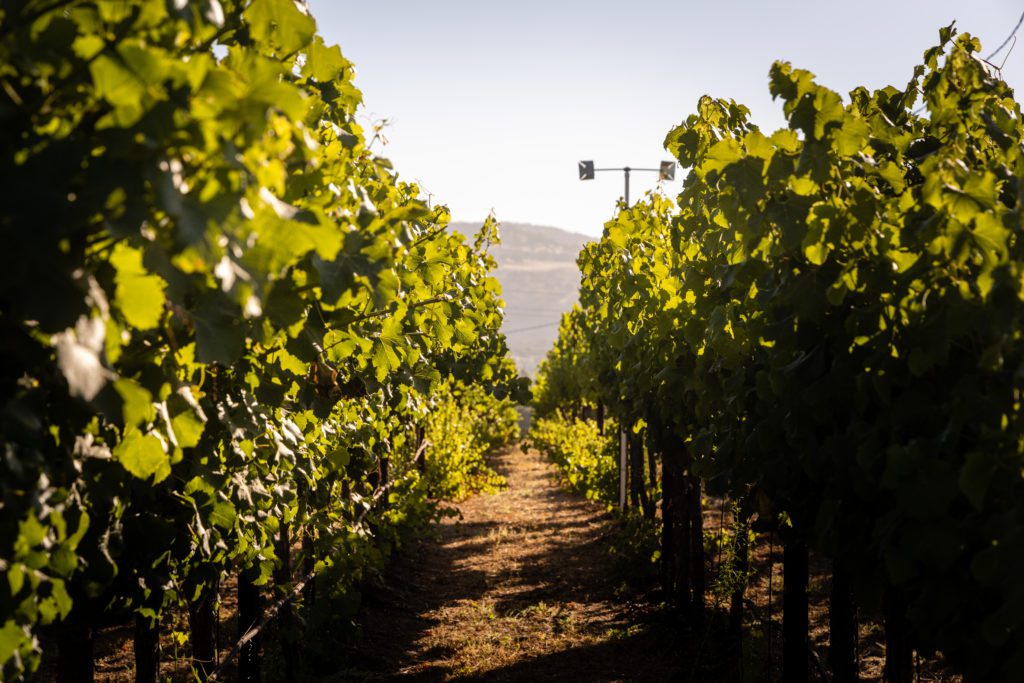The Rise of Atlas Peak AVA

Atlas Peak wines are the pinnacle of Napa Valley winemaking. Quite literally.
At 2,663ft above sea level, these vineyards are some of the highest in the region.
The Atlas Peak appellation is located within the Soda Canyon and Foss Valley areas. The AVA is northeast of the town of Napa, east of Yountville, and above the foothills of the Stags Leap District. Vineyards were first planted on Atlas Peak in 1870, with the terrain growing steadily between 1880 and 1901. The first winery was established in the early 1980s, and the appellation was given official AVA status in 1992. Today, Atlas Peak is the proud home of Seven Apart. But what is it that makes this area so special?
A Solid Bedrock
The answer is simple: location, location, location. Millions of years ago, Mount Saint Helena erupted spewing lava and ash across what today is Napa Valley. Since then, much of the land has been cultivated, but certain hard-to-reach areas still remain covered in huge boulders of volcanic rock.
Volcanic rock is one of the rarest types of soil in the world, accounting for less than two percent of the soil cover in the United States. The basaltic red-colored soil is incredibly fertile because it is derived from volcanic lava and ash, both of which are filled with nutrients such as iron, calcium, and magnesium. This rich combination acts as a stimulant for growing plants – such as vines. Another factor that makes volcanic soil ideal for growing grapes is that it is porous with limited water retention, which permits the vine to cool down quickly on warm, sunny days.
The volcanic soils and topography are also closer to the sun’s nurturing rays. The westward orientation of most vineyards on the Vaca Mountains extends the amount of direct sunlight on the grapes, which is key for ripening. The Atlas Peak appellation sits on a higher elevation than most of Napa’s wine region which enjoys the cleansing breezes off San Francisco Bay and limits the effects of the cool fog coming in from the Pacific Ocean. The area has a significant diurnal temperature variation upwards of 30 °F between daytime and night. This contributes to the balance of acidity in the grapes. Together, all these factors create a unique microclimate for which Atlas Peak is celebrated.
Mountain High
Historically, the region grew many grape varieties, but today, Atlas Peak is best known for its expressive mountain Cabernet Sauvignon and Bordeaux varietals. These varieties thrive in the cool climate conditions that produce wines known for their intense flavors and delicate, balanced tannins. These wines are also considerably different from those made on the valley floor.
Ask any Atlas Peak grape grower, and they will attest to the difficulty in cultivating fruit within this highly elevated, rugged, and striking landscape. Mountain grown vineyards are far more difficult to farm and the growing season tends to be considerably longer. Higher elevations also have greater diurnal temperature swings and these features can create noticeable differences in the styles of wine they produce. It’s much more difficult to plant and establish the vines, and the vines tend to produce far lower yields. Mountain fruit shares the dark color and full body as Valley-floor wines, but tends to have a rustic edge with more structure.
In fact, it was as recent as 1999 that one brave vintner decided to excavate the top of Atlas Peak, approximately 1,475ft above the valley floor. At that point, the volcanic rocks were the size of small cars! But determination paid off, and the land was finally cleared and planted with grapevines. The vineyard was named Stags Ridge, and in 2013, it produced the elusive unicorn that is the 100-point winning wine. In August 2018, founder Don Dady purchased the Stags Ridge vineyard, which today is home to Seven Apart’s prized Cabernet Sauvignon vines.
Our winemaker Andy Erickson reflects on setting up the Stags Ridge vineyard for production in late 2019:
“Wines grown in volcanic soils tend to be produced in small quantities as the land is difficult to plant and farm. Stags Ridge was no different. The soil was more like a cobblestone street, with giant rocks everywhere making trellising a near-impossible task! ”
While excellence does not come easy, Andy and the Seven Apart team persevered.
Discernibly Different
Today, the resulting Seven Apart wines grown in our Atlas Peak mountain vineyard are impressively bold with greater red fruit characteristics. Andy explains that the wine can take a bit more time to age before revealing true complexity and depth:
“Patience is always a virtue when it comes to wine. Atlas Peak truly produces some of the greatest fruit Napa has to offer,” he muses.
Seven Apart Cabernet Sauvignon grown in our Atlas Peak Stag’s Ridge vineyard is complex, balanced, and has big tannins that soften with time. Each parcel has so much variation that we craft three different expressions of Cabernet Sauvignon from the same vineyard, namely Seven Apart Shale, Seven Apart Basalt, and Seven Apart Summit.
“There is so much to discover within this vineyard. Perched above the fog line, Atlas Peak provides perfect conditions for longer hang times and the gradual development of phenolic ripeness – the components that make these wines some of the most intense and balanced in Napa Valley. Those seeking savouriness, complexity, and structured tannins will appreciate the beauty found with wines made up on the mountains,” ends Andy.
As Atlas Peak AVA gains more and more recognition as an outstanding terroir, many are starting to understand the power behind these wines. It’s certainly a steep climb to the top: but the results are worth it.
